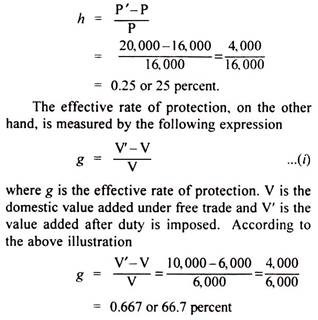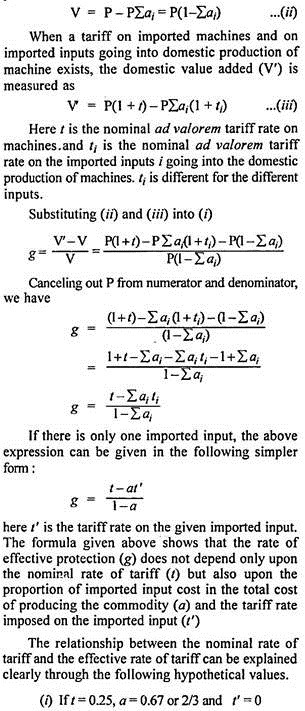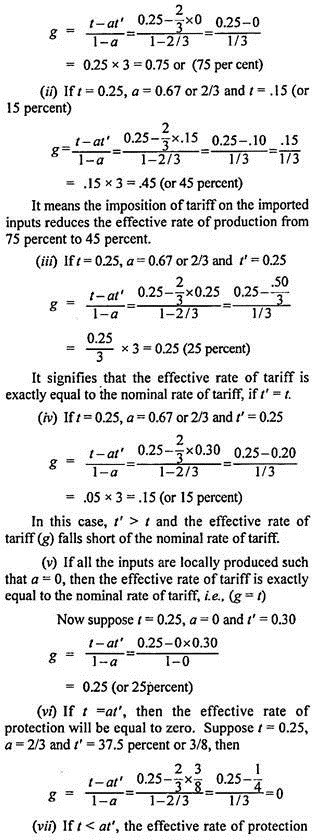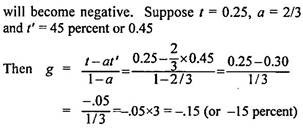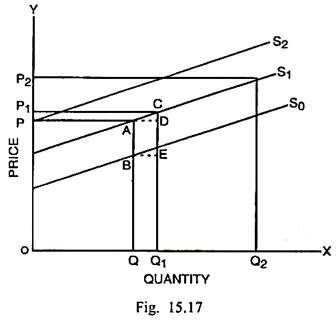In this article we will discuss about:- 1. Concept of Effective Rate of Protection 2. Assumptions of Effective Rate of Protection 3. Importance 4. Limitations.
Concept of Effective Rate of Protection:
Until the early 1960’s, the official rate of tariff was intended to discourage the import of final product and to promote the domestic production in the protected industry. The rate of tariff ad valorem on the import of final product was called as the nominal rate of tariff. A ten percent tariff on a finished imported good was supposed to have a ten percent protection to the domestically produced import substitute.
Higher the rate of nominal tariff, it was assured, higher would be the degree of protection and vice-versa. In other words, the nominal rate of tariff was used to be regarded as a measure of the degree of protection.
ADVERTISEMENTS:
The writers like B. Balassa, W. Corden and H.G. Johnson suggest that the nominal rate of tariff was not the appropriate measure of the degree of protection. According to them, the concept of nominal rate of tariff had a serious flaw that it considered only the effect of tariff on final imported product.
It did not recognise the structure of duties applied to the imported raw materials and intermediate goods required in the processing of the import substitutes. A country, many often, imports a raw material either duty-free or imposes a very low tariff rate on the imports of inputs than on the import of final commodity.
Such a policy is adopted for encouraging domestic production and expansion of employment. For instance, a country may import raw cotton duty free but impose a stiff rate of tariff on the import of cloth. Such a structure of import tariff brings about a relatively larger increase in the domestic value added.
The domestic value added equals the price of the final commodity minus the cost of the imported inputs going into the production of the commodity. When no or lower tariffs are applied on imported inputs than on the final imported product, the rate of protection, called as the effective rate of production, exceeds the nominal tariff rate.
ADVERTISEMENTS:
The concept of effective rate of protection has been defined by Balassa in these words- “Under the usual assumptions of international -immobility of labour and capital, the effective rate of duty will indicate the degree of protection of the value added in the manufacturing process.” In other words, the effective rate of tariff establishes a relationship between the tariff and the domestic value added. Such a tariff rate can be a true measure of the actual rate of protection that the nominal tariff affords to the domestic import-competing industries. In the words of Corden, “The effective protective rate is the percentage increase in value added per unit in an economic activity which is made possible by the tariff structure relative to the situation in the absence of tariff but with the same exchange rate”.
Assumptions of Effective Rate of Protection:
Corden’s theory of effective rate of protection rests upon the following main assumptions:
(i) There is constancy of physical input- output co-efficients.
(ii) The primary inputs are available in fixed quantities.
ADVERTISEMENTS:
(iii) The primary inputs are immobile between the countries.
(iv) The elasticity co-efficients related to demand for all exports and supply of all imports are infinite.
(v) Trade takes place in case of all the inputs.
(vi) The economic system is maintained in the state of full employment through appropriate monetary and fiscal policies.
(vii) All tariffs and other measures like taxes or subsidies are applied on a non-discriminatory basis.
(viii) All tradable goods continue to remain tradable even after tariff and other measures are adopted so that the domestic price of each importable good is given by the foreign price plus tariff.
Given the above assumptions, the distinction between the nominal and effective rate of protection can be understood through an illustration. Suppose imported special steel worth Rs. 10,000 is required for producing domestically a machine. The free trade price of machine is Rs. 16,000. If 25 percent nominal tariff is imposed on each imported machine, its price for domestic consumer will be Rs. 20,000. Out of this, Rs. 10,000 represent imported steel, Rs. 6,000 is the domestic value added and Rs. 4,000 is the tariff.
Rs. 4,000 tariff obtained from each imported machine signifies a 25 percent nominal tariff rate because the nominal tariff is calculated on the price of the final commodity [(4,000/16,000) × 100 = 25 Percent]. The rate of effective tariff is, however, much larger as it is calculated on the domestic value added. In this illustration, it amount to [(4,000/16,000) × 100 = 66.7 Percent].
It implies that 25 percent nominal tariff provides 66.7 percent of the value of domestic processing. Thus the effective rate of protection is 2.67 times more than that indicated by the nominal tariff. It is, in fact, the effective rate of tariff protection that is significant for the domestic producers as it makes them expand the domestic production of machines in competition with the imported machines.
ADVERTISEMENTS:
From the viewpoint of consumers, on the opposite, the matter for concern only is that 25 percent tariff increases the price of imported machine by Rs. 4,000. From the above illustration, the conclusion follows that the effective rate of protection will exceed the nominal tariff rate, whenever the imported input is admitted duty free or a lower tariff rate is imposed on the imported input than on the final commodity produced with the imported input.
The nominal tariff rate can be expressed through the following formula:
H = (P’ – P) / P
Where h is the nominal tariff rate. P is the world price in the absence of tariff and P’ is the domestic price of the final commodity including tariff. In the illustration given above, the nominal tariff rate is 0.25 or 25 percent.
ADVERTISEMENTS:
The domestic value added in a machine produced in the home country under free trade is determined by the international fixed prices of the machine under free trade minus the cost of all imported inputs at their fixed international free trade price-
ADVERTISEMENTS:
After the implementation of Tokyo Round of multilateral trade negotiations, the estimates related to the nominal and effective tariff rates that prevailed in the U.S.A., the European Community and Japan in 1986 showed that the highest nominal tariff rate in the U.S.A. was 22.7 percent on wearing apparels and the effective tariff rate on them was 43.3 percent. In the European Community, the highest nominal tariff rate was 13.4 percent again on wearing apparels with the corresponding effective tariff rate of 19.3 percent.
The highest effective rate of protection was, however, 20.7 percent in the case of footwear. The highest nominal tariff rate in Japan was 25.4 percent on food, beverages and tobacco with the corresponding effective tariff rate of 50.3 percent. The average nominal tariff rate was the lowest in the U.S.A. and almost the same in the European Community and Japan. The average effective rate of tariff was the lowest in the U.S.A. and the highest in Japan.
The effective rate of protection can also be determined diagrammatically as shown through Fig. 15.17. Since the demand is not supposed to be affected by tariff, it has not been shown.
In Fig. 15.17, S1 is the supply curve of the final product machine and S0 is the supply curve of labour, which is the only primary factor. The quantity of machines is measured along the horizontal scale and price is measured along the vertical scale.
ADVERTISEMENTS:
AQ or OP is the constant free trade international price of the machine and OQ is the input of labour employed. The unit value added is measured by BQ/AQ. As tariff is imposed upon the imported machine, its domestic price rises from OP to OP2 and the domestic production of machine expands form OQ to OQ2.
If an additional tariff is levied upon the imported inputs of this commodity, the supply curve shifts up from S1 to S2. Consequently, the production of machine contracts from OQ2 to OQ1. However, there is a net increase in production to the extent of QQ1. This is on account of PP1 which is the difference between the increase in the domestic price (PP2) and increase in the unit cost of production (P1P2), i.e., PP1 = PP2 – P1P2. The effective rate of production (g) is measured by dividing PP1 by the value added or the contribution of the primary factor.
Therefore,
g = PP1/BQ = CD/EQ1
Importance of Effective Rate of Protection:
The concept of effective rate of protection has much importance as discussed below:
(i) Importance for Producers:
ADVERTISEMENTS:
While the concept of nominal rate of tariff is important from the point of view of the consumers because of their concern with the rise in the price of the final product after tariff, the concept of effective rate of protection or tariff has significance from the viewpoint of the producers.
When a tariff is imposed on the primary inputs or raw materials, the production decisions are likely to get affected. The tariff policies are often intended to bring about an increase in the domestic value added.
(ii) Impact on Resource Allocation:
It cannot be controverted that the tariff structure can affect the direction of resource allocation. To quote Corden, “Ordinary nominal tariffs apply to commodities but resources move as between economic activities. Therefore, to discover the resource allocation effects of a tariff structure, one must calculate the protective rate for each activity that is the effective protective rate.”
(iii) Nature of Tariff Structure:
The concept of effective rate of protection also sheds light upon the nature of tariff structure in a country. A widely observed feature of tariff structure in many a country is that the nominal rates tend to be low or even zero for raw materials and rise or escalate with the degree of processing. For instance, the nominal tariff rates may be the lowest in the case of raw cotton but may tend higher and higher in case of yarn, cloth and apparels respectively.
ADVERTISEMENTS:
(iv) Expansion of Trade:
The concept of effective rate of protection signifies that a reduction in nominal rates of tariff on the imported raw materials needed for the domestic processing seems to be a concession for the foreign country intended to expand the volume of trade. In fact, it results in a rise in effective rate of protection of the user industry. The increase in protected production may actually have opposite consequences for the volume of trade.
(v) Expansion of Infant Industries:
The concept of effective rate of protection brings home the fact how a greater degree of protection can be afforded for rapid expansion of infant industries. It suggests that the countries need not impose high nominal tariff rates for protecting their infant industries. A significantly higher rate of protection can be achieved by lowering down the structure of tariff rates on intermediate products to be used in the infant industry.
(vi) Multiple Exchange System:
The concept of effective rate of protection can be used to analyse the multiple exchange rate system. Any exchange rate, official or market rate, assumed as a base rate may initially be taken. Then all exchange rates applicable to imports and exports may be converted into nominal tariff rates, import subsidies, export taxes or export subsidies. Suppose the exchange rate of capital goods imports is Rs. 50 per dollar and the base rate is Rs. 45 per dollar.
ADVERTISEMENTS:
It implies an import tariff of 11.1 percent. It can be converted into an effective rate according to the procedure. Given sets of nominal rates, effective rates and elasticity coefficients, a single rate of exchange can be estimated that can achieve the same balance of payments equilibrium as can be possible through a system of multiple exchange rates.
(vii) Impact of Foreign Tariff:
This concept can be employed also for analysing the effects of foreign tariff upon the trade and growth of the home country and necessary actions that can be taken for off-setting any adverse effect of the foreign tariffs.
(viii) Degree of Protection:
The government and economists are interested in measuring the degree of protection extended to different industries. The concept of effective rate of protection has crucial importance in this respect. The tariff policies are so devised to achieve the desired effects upon the domestic industries.
A number of empirical studies related to nominal and effective rates of protection have been made by the writers including Balassa, H.G. Johnson, Deardorff, Stern, A.J. Yeats, Szenberg and Lombardt. Most of these studies point to the fact that the effective rates of protection are much greater than the nominal rates of tariff in the advanced countries.
The advanced countries including the U.S.A., Canada, the European Union and Japan allow the import of primary products or intermediate products either duty free or at low nominal tariff rates or maintain a higher structure of nominal tariff rates upon the imports of finished products.
Consequently, the effective rate of production is significantly high in the advanced countries. It has a detrimental effect upon the industrial expansion in the less developed countries, as their products do not enjoy an easy access to the markets of the advanced countries.
Limitations of Effective Rate of Protection:
The theory of effective rate of protection has certain theoretical and practical limitations, which are pointed out below:
(i) Faulty and Restrictive Assumptions:
The concept of effective rate of protection rests upon a series of faulty, restrictive and unrealistic assumptions such as fixity of input-output co-efficients, fixed supply of primary inputs, infinite elasticity coefficients and full employment of resources. The faulty theoretical structure of this concept greatly limits its practical applicability.
(ii) Partial Equilibrium Analysis:
A major limitation of the concept is that it is based upon the partial equilibrium analysis or particular product analysis. When import tariff raises the price of imported input, the domestic producers are likely to substitute cheaper domestic or imported inputs in products. Such effects have been overlooked. A more realistic explanation of it can be made in a general equilibrium setting.
(iii) Difficulties in International Comparisons of Effective Rates of Production:
There are real problems in the exact measurement of heights of tariffs and comparison of tariff rates in one country with the other in the view of the presence or absence of certain groups of commodities or their varieties. If the weighted average of tariff rates is to be computed, the difficulty can arise when the tariff rate is so high that the imports get completely stopped. On the opposite, if the un-weighted average is computed, major and minor items of imports are given equal importance that is not realistic.
(iv) Neglect of Indirect Effects:
The concept of effective rate of protection attempts to measure the rate of protection in case of specified home industries by taking into account only the direct effects of tariff upon those industries. The tariffs also have certain indirect effects including the counterveiling measures adopted by foreign countries. As these effects remain neglected, the effective rate of protection cannot measure precisely the degree of protection.
(v) Neglect of Non-Traded Inputs:
This concept rests upon the assumption that the inputs are internationally traded. In fact, some inputs are not traded. However their values are included in the total values of inputs and output. Consequently, the measurement of effective rate of protection is rendered faulty.
(vi) Misallocation of Resources:
The tariffs certainly influence the allocation of resources. There is a danger that the primary or intermediate inputs flow into such industries, as have the highest protective rates and away from such industries in case of which the protective rates are the lowest or negative. This clearly amounts to a misallocation of resources.
Despite its deficiencies, the concept of effective rate of protection has vital importance because it measures the extent to which the home market of a country is sheltered. This issue has assumed significance in international negotiations related to trade and tariff. It must be fully recognised that the lowering down of nominal tariff rates does not actually ensure trade liberalisation. It is the reduction in effective rates of tariffs that constitutes a move towards freer international trade.
